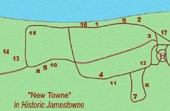
NPS artist Sydney King As early as 1614, colonist Ralph Hamor reported that Jamestown had “two faire rowes of howses, all of framed Timber.” Only a few years later, a new development project began, when William Claiborne, sent to the colony to survey Virginia land grants, was called upon to plan a “new town” to the east of the fort and the “two faire rowes of howses.” In 1624, Hamor was granted an acre and a half in the “new town.” The deed description makes it clear that at least three streets had already been laid out. A “highway” ran perpendicular to the James, connecting a street following the riverbank with “the backstreete.” Other early settlers who owned property along this street included William Peirce, Dr. John Pott, Governor Sir Francis Wyatt and future governor John Harvey. In the following decades, building incentives resulted in the construction of fine brick homes on Back Streete by such Virginia notables as Richard Kemp, William Sherwood, Henry Hartwell and William May. A four-dwelling rowhouse was probably built after Governor Sir William Berkeley’s Town Act of 1662. Even when Williamsburg became Virginia’s new capital, the Back Streete area retained its cachet. In the 1750s, colonist Richard Ambler would build a mansion (now in ruins) nearby as a centerpiece of a thriving plantation. |
Last updated: February 26, 2015

